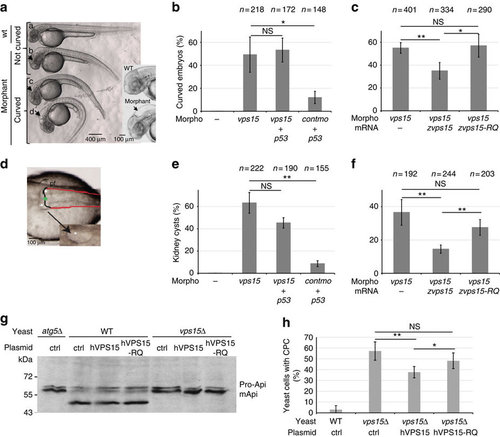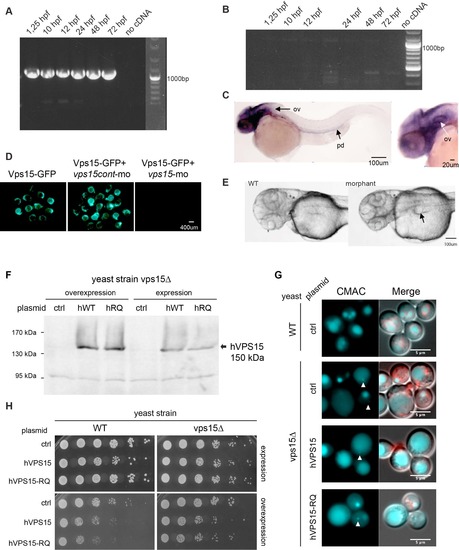- Title
-
A mutation in VPS15 (PIK3R4) causes a ciliopathy and affects IFT20 release from the cis-Golgi
- Authors
- Stoetzel, C., Bär, S., De Craene, J.O., Scheidecker, S., Etard, C., Chicher, J., Reck, J.R., Perrault, I., Geoffroy, V., Chennen, K., Strähle, U., Hammann, P., Friant, S., Dollfus, H.
- Source
- Full text @ Nat. Commun.
|
Zebrafish and yeast models to determine the VPS15-R998Q defects. (a) The vps15 morphants injected with vps15-mo (b?d) show different degrees of body axis curvature and hydrocephaly (black arrows and zoom) compared with the control (vps15cont-mo; a). For quantification, only phenotypes c and d were considered curved. Fifty-six hours post-fertilization embryos were used. (b) Percentage of curved embryos among the population injected with different combinations of morpholinos (Morpho). (c) Percentage of curved embryos upon co-injection with vps15-mo plus zVPS15 wild-type (VPS15) or zVPS15-RQ mRNA. In b and c, n indicates the number of injected embryos that were counted. Statistical significance was determined using the Student?s t-test, NS, non-significant, *P<0.05, **P<0.01 (d) Pronephric cysts (white stars) were observed in vps15 morphants. Black line: pronephric tubule; green dot: glomerulus; red line: pronephric duct; pf: pectoral fin. (e) Percentage of embryos forming kidney cysts upon injection with different combinations of morpholinos. (f) vps15 morphants co-injected with VPS15 wild-type or VPS15-RQ mRNA. In e and f, n indicates the number of injected embryos that were counted. Statistical significance was determined using the Student?s t-test, NS, non-significant, **P<0.01 (g) The wild-type (WT), atg5? and vps15? yeast cells bearing ctrl, hVPS15 or hVPS15-RQ plasmid, were grown under nitrogen deprivation for 4?h to induce autophagy and then collected. Western blot was performed to show the immature (proApi) and mature (mApi) forms of the vacuolar protease Api (Aminopeptidase 1). (h) vps15? yeast cells were transformed with the empty (ctrl), the wild-type hVPS15 or the mutant hVPS15-R998Q plasmid and the percentage of cells displaying an additional CMAC-positive compartment (CPC) was determined. At least 100 cells per experiment and transformant were counted. Graph shows mean of three experiments. Statistical significance was determined using the Student?s t-test, NS, non-significant, *P<0.05, **P<0.01. All the data shown in the figure are from at least three independent experiments and error bars represent s.d. PHENOTYPE:
|
|
Controls of zebrafish and yeast experiments. A-B: RT-PCR with cDNA of 6 different developmental stages (from 1,25 to 72 hpf) amplifies a 1000 bp band (arrow) as expected. vps15 mRNA is maternally expressed before midblastula transition (1,25 hpf) and mRNA is detectable until at least 72 hpf. PCR without prior reverse transcription did not yield a 1000 bp band (B) indicating that the amplified fragment is not due to contamination with cDNA or genomic DNA. C: In situ hybridization with vps15 antisense probe in zebrafish embryos showing ubiquitous expression at 14 hpf and prominent localization in the head as well as in the pronephric duct (pd) at 48 hpf. Ov: otic vesicle. D. Co-injection of vps15-mo with zVps15-GFP plasmid completely blocked GFP expression. As expected, co-injection of the mismatch control vps15cont-mo with the zVps15-GFP reporter did not reduce the GFP expression as compared to controls injected with the zVps15- GFP plasmid. Embryos are 20 hpf old. E picture of WT and morphant zebrafish showing kidney cysts in the morphant (black arrow) but not the WT. F. vps15? yeast cells were transformed with a control empty plasmid (ctrl), an expression (CEN) or overexpression (2?) plasmid bearing wild-type hVPS15 or mutant hVPS15-R998Q and a western blot against hVPS15 was performed. G. Wild-type (WT) and vps15? yeast cells transformed with a control (ctrl), hVPS15 or hVPS15-R998Q expression plasmid (CEN) were labeled with a soluble dye (CMAC) staining the lumen of the vacuole. White arrows show the additional CMAC positive compartment (CPC) in vps15? yeast cells. H. Drop test assays of wild-type WT and vps15? yeast cells expressing (CEN) or overexpressing (2?) hVPS15 or hVPS15- R998Q. Plates were incubated at 30°C. Yeast strains transformed with an empty plasmid (ctrl) were used as controls. EXPRESSION / LABELING:
PHENOTYPE:
|


